
Illustrative Math Alignment: Grade 6 Unit 1
Dividing Fractions
Lesson 16: Solving Problems Involving Fractions
Use the following Media4Math resources with this Illustrative Math lesson.
| Thumbnail Image | Title | Body | Curriculum Nodes |
|---|---|---|---|
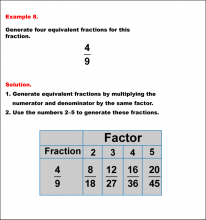
|
Math Example--Fraction Properties--Generating Equivalent Fractions: Example 8 | Generating Equivalent Fractions: Example 8TopicFractions |
Find Equivalent Fractions and Fractions and Mixed Numbers |
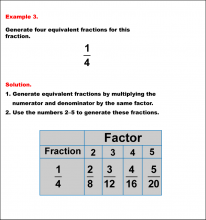
|
Math Example--Fraction Properties--Generating Equivalent Fractions: Example 3 | Generating Equivalent Fractions: Example 3TopicFractions |
Find Equivalent Fractions and Fractions and Mixed Numbers |
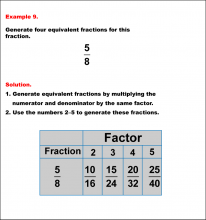
|
Math Example--Fraction Properties--Generating Equivalent Fractions: Example 9 | Generating Equivalent Fractions: Example 9TopicFractions |
Find Equivalent Fractions and Fractions and Mixed Numbers |

|
Math Example--Fraction Properties--Generating Equivalent Fractions: Example 1 | Generating Equivalent Fractions: Example 1TopicFractions |
Find Equivalent Fractions and Fractions and Mixed Numbers |

|
Math Example--Fraction Properties--Generating Equivalent Fractions: Example 12 | Generating Equivalent Fractions: Example 12TopicFractions DescriptionThis example focuses on the method of generating equivalent fractions by applying a scale factor to both the numerator and the denominator. By multiplying by the same number, the fraction is effectively multiplied by 1, maintaining its original value. This technique is crucial for simplifying fractions and understanding their properties. The skills involved include multiplication, recognizing equivalent fractions, and logical reasoning to ensure the fractions remain equivalent. This understanding is foundational for more advanced mathematical concepts such as algebra and calculus. |
Find Equivalent Fractions and Fractions and Mixed Numbers |
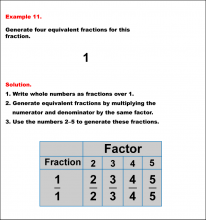
|
Math Example--Fraction Properties--Generating Equivalent Fractions: Example 11 | Generating Equivalent Fractions: Example 11TopicFractions |
Find Equivalent Fractions and Fractions and Mixed Numbers |
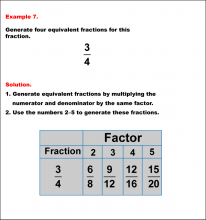
|
Math Example--Fraction Properties--Generating Equivalent Fractions: Example 7 | Generating Equivalent Fractions: Example 7TopicFractions DescriptionThis example focuses on the method of generating equivalent fractions by applying a scale factor to both the numerator and the denominator. By multiplying by the same number, the fraction is effectively multiplied by 1, maintaining its original value. This technique is crucial for simplifying fractions and understanding their properties. The skills involved include multiplication, recognizing equivalent fractions, and logical reasoning to ensure the fractions remain equivalent. This understanding is foundational for more advanced mathematical concepts such as algebra and calculus. |
Find Equivalent Fractions and Fractions and Mixed Numbers |
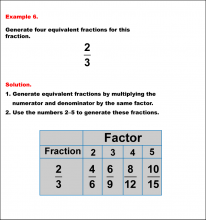
|
Math Example--Fraction Properties--Generating Equivalent Fractions: Example 6 | Generating Equivalent Fractions: Example 6TopicFractions |
Find Equivalent Fractions and Fractions and Mixed Numbers |

|
Math Example--Fraction Properties--Generating Equivalent Fractions: Example 5 | Generating Equivalent Fractions: Example 5TopicFractions |
Find Equivalent Fractions and Fractions and Mixed Numbers |
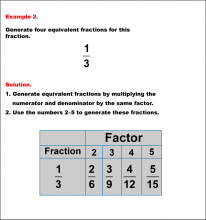
|
Math Example--Fraction Properties--Generating Equivalent Fractions: Example 2 | Generating Equivalent Fractions: Example 2TopicFractions DescriptionThis example focuses on generating equivalent fractions by applying a scale factor to both the numerator and the denominator. By doing so, the fraction is effectively multiplied by 1, preserving its original value while altering its form. This method is essential for simplifying fractions and understanding their properties. The skills involved include multiplication, recognizing equivalent fractions, and applying logical reasoning to ensure the fractions remain equivalent. Mastery of this concept is vital for more advanced mathematical topics such as algebra and calculus. |
Find Equivalent Fractions and Fractions and Mixed Numbers |
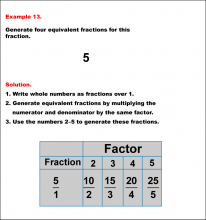
|
Math Example--Fraction Properties--Generating Equivalent Fractions: Example 13 | Generating Equivalent Fractions: Example 13TopicFractions |
Find Equivalent Fractions and Fractions and Mixed Numbers |
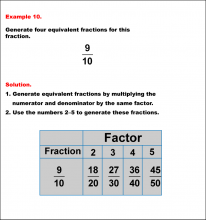
|
Math Example--Fraction Properties--Generating Equivalent Fractions: Example 10 | Generating Equivalent Fractions: Example 10TopicFractions DescriptionThis example focuses on the method of generating equivalent fractions by applying a scale factor to both the numerator and the denominator. By multiplying by the same number, the fraction is effectively multiplied by 1, maintaining its original value. This technique is crucial for simplifying fractions and understanding their properties. The skills involved include multiplication, recognizing equivalent fractions, and logical reasoning to ensure the fractions remain equivalent. This understanding is foundational for more advanced mathematical concepts such as algebra and calculus. |
Find Equivalent Fractions and Fractions and Mixed Numbers |
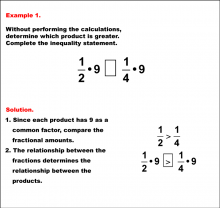
|
Math Example--Fraction Properties--Comparing Fraction Products: Example 1 | Comparing Fraction Products: Example 1TopicComparing Fractions |
Fractions and Mixed Numbers |
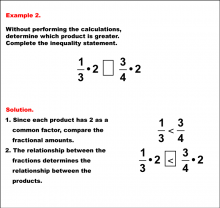
|
Math Example--Fraction Properties--Comparing Fraction Products: Example 2 | Comparing Fraction Products: Example 2TopicComparing Fractions DescriptionThis example illustrates the process of comparing the products of fractions. The image shows a scenario where two fractions are multiplied and their products are compared to determine which is greater. The mathematical concept involves understanding how to multiply fractions and compare the resulting products. Key skills include fraction multiplication, simplification, and comparison. Solving this problem often requires an algorithmic method where fractions are multiplied and then compared, or a visual model might be employed to provide a clearer understanding of the size of each product relative to the other. |
Fractions and Mixed Numbers |
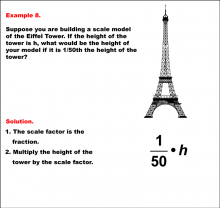
|
Math Example--Fraction Properties--Comparing Fraction Products: Example 8 | Comparing Fraction Products: Example 8TopicComparing Fractions DescriptionThis example demonstrates the process of identifying a fraction product in a word problem. The image illustrates a scale model situation. This involves understanding fraction multiplication and comparison. Skills required include multiplying fractions, simplifying them, and comparing the results. The problem is solved using an algorithmic method, where fractions are multiplied and compared, or through a visual model that helps visualize the relative sizes of the products. |
Fractions and Mixed Numbers |

|
Math Example--Fraction Properties--Comparing Fraction Products: Example 5 | Comparing Fraction Products: Example 5TopicComparing Fractions DescriptionThis example demonstrates how to compare the products of fractions. The image shows a fraction product compared to a whole number. The concept requires understanding fraction multiplication and comparison. Skills involved include multiplying fractions, simplifying them, and comparing the results. The problem can be solved using an algorithmic method, where fractions are multiplied and compared, or through a visual model that illustrates the relative sizes of the products. |
Fractions and Mixed Numbers |
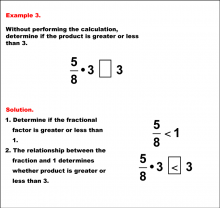
|
Math Example--Fraction Properties--Comparing Fraction Products: Example 3 | Comparing Fraction Products: Example 3TopicComparing Fractions DescriptionThis example focuses on comparing the products of fractions. The image depicts a fraction product compared to a whole number. The concept involves multiplying fractions and comparing the results to see which is larger or smaller. Skills required include multiplying fractions, simplifying them, and comparing the numerical outcomes. This problem can be solved using a straightforward algorithm where each fraction is multiplied, and the products are compared, or through a visual model that helps illustrate the relative sizes and relationships between the products. |
Fractions and Mixed Numbers |
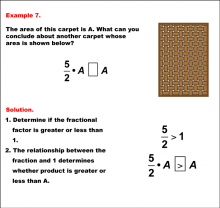
|
Math Example--Fraction Properties--Comparing Fraction Products: Example 7 | Comparing Fraction Products: Example 7TopicComparing Fractions DescriptionThis example illustrates the concept of comparing a fraction product to a whole number. The image shows an improper fraction product. This involves understanding fraction multiplication and comparison. Skills involved include multiplying fractions, simplifying them, and comparing the outcomes. The problem is typically solved using an algorithmic approach, where fractions are multiplied and compared, or through a visual model that helps visualize the relative sizes of the products. |
Fractions and Mixed Numbers |

|
Math Example--Fraction Properties--Comparing Fraction Products: Example 6 | Comparing Fraction Products: Example 6TopicComparing Fractions DescriptionThis example focuses on comparing a fraction product to a whole number. The image depicts an area calculation problem. This concept involves understanding how to multiply fractions and compare the results. Skills required include fraction multiplication, simplification, and comparison. The problem can be solved using an algorithmic approach, where each fraction is multiplied and the products are compared, or through a visual model to illustrate the relative sizes of the products. |
Fractions and Mixed Numbers |
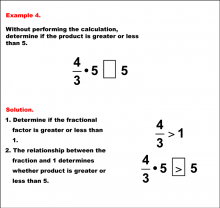
|
Math Example--Fraction Properties--Comparing Fraction Products: Example 4 | Comparing Fraction Products: Example 4TopicComparing Fractions DescriptionThis example highlights the process of comparing products of fractions. The image illustrates a fraction product compared to a whole number, with the resulting products compared to see which is larger. This concept involves understanding the multiplication of fractions and the comparison of their products. Skills required include multiplying fractions, simplifying them, and comparing the outcomes. The problem is solved using an algorithmic approach, where each fraction is multiplied and the products are compared, or through a visual model that helps visualize the relative sizes of the products. |
Fractions and Mixed Numbers |

|
Math Example--Fraction Properties--Comparing Fraction Products: Example 9 | Comparing Fraction Products: Example 9TopicComparing Fractions DescriptionThis example focuses on generating a fraction product in a word problem situation. This concept involves understanding how to multiply fractions and compare the results. Skills required include fraction multiplication, simplification, and comparison. The problem can be solved using an algorithmic approach, where each fraction is multiplied and the products are compared, or through a visual model to illustrate the relative sizes of the products. |
Fractions and Mixed Numbers |
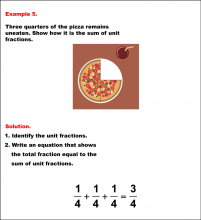
|
Math Example--Fraction Properties--Decomposing Fractions: Example 5 | Decomposing Fractions: Example 5TopicFraction Properties DescriptionThis example illustrates decomposing fractions by breaking down a fraction into a sum of smaller fractions with the same denominator. The visual representation helps in understanding the breakdown of complex fractions into simpler parts. Essential skills include recognizing equivalent fractions, performing fraction addition, and applying decomposition techniques, which are crucial for mastering advanced fraction operations. |
Add and Subtract Fractions |

|
Math Example--Fraction Properties--Decomposing Fractions: Example 1 | Decomposing Fractions: Example 1TopicFraction Properties DescriptionThis example demonstrates the concept of decomposing fractions, which involves breaking down a fraction into a sum of fractions with the same denominator. The visual representation helps in understanding how a single fraction can be expressed as a combination of smaller fractions. Skills involved include recognizing equivalent fractions, understanding fraction addition, and applying decomposition techniques, which are essential for mastering more complex fraction operations. |
Add and Subtract Fractions |
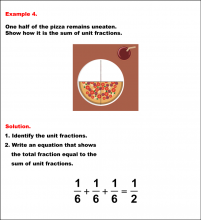
|
Math Example--Fraction Properties--Decomposing Fractions: Example 4 | Decomposing Fractions: Example 4TopicFraction Properties DescriptionThis example demonstrates decomposing fractions by expressing a fraction as a sum of smaller fractions with the same denominator. The image aids in visualizing the simplification of complex fractions into simpler components. Key skills include understanding fraction equivalence, performing fraction addition, and applying decomposition strategies, which are foundational for further studies in fractions. |
Add and Subtract Fractions |
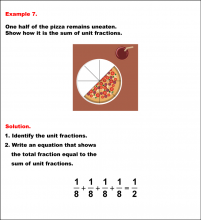
|
Math Example--Fraction Properties--Decomposing Fractions: Example 7 | Decomposing Fractions: Example 7TopicFraction Properties DescriptionThis example focuses on decomposing fractions, showing how a fraction can be divided into a sum of fractions with the same denominator. The visual representation helps in understanding the breakdown of complex fractions into simpler parts. Essential skills include recognizing equivalent fractions, performing fraction addition, and applying decomposition techniques, which are crucial for mastering advanced fraction operations. |
Add and Subtract Fractions |

|
Math Example--Fraction Properties--Decomposing Fractions: Example 3 | Decomposing Fractions: Example 3TopicFraction Properties DescriptionThis example focuses on decomposing fractions, showing how a fraction can be divided into a sum of fractions with the same denominator. The visual representation helps in understanding the breakdown of complex fractions into simpler parts. Essential skills include recognizing equivalent fractions, performing fraction addition, and applying decomposition techniques, which are crucial for mastering advanced fraction operations. |
Add and Subtract Fractions |

|
Math Example--Fraction Properties--Decomposing Fractions: Example 8 | Decomposing Fractions: Example 8TopicFraction Properties DescriptionThis example illustrates decomposing fractions by breaking down a fraction into a sum of smaller fractions with the same denominator. The visual representation helps in understanding the breakdown of complex fractions into simpler parts. Essential skills include recognizing equivalent fractions, performing fraction addition, and applying decomposition techniques, which are crucial for mastering advanced fraction operations. |
Add and Subtract Fractions |
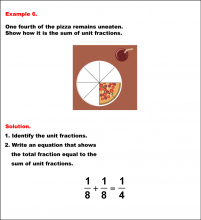
|
Math Example--Fraction Properties--Decomposing Fractions: Example 6 | Decomposing Fractions: Example 6TopicFraction Properties DescriptionThis example demonstrates decomposing fractions by expressing a fraction as a sum of smaller fractions with the same denominator. The image aids in visualizing the simplification of complex fractions into simpler components. Key skills include understanding fraction equivalence, performing fraction addition, and applying decomposition strategies, which are foundational for further studies in fractions. |
Add and Subtract Fractions |

|
Math Example--Fraction Properties--Decomposing Fractions: Example 2 | Decomposing Fractions: Example 2TopicFraction Properties DescriptionThis example illustrates decomposing fractions by breaking a fraction into a sum of smaller fractions with the same denominator. The image aids in visualizing how complex fractions can be simplified into simpler components. Key skills include understanding fraction equivalence, performing fraction addition, and applying decomposition strategies, which are foundational for more advanced fraction concepts. |
Add and Subtract Fractions |

|
Worksheet: The Language of Math--Fractions, Worksheet 4 | Worksheet: The Language of Math--Fractions, Worksheet 4
This is part of a collection of math worksheets on the topic of the language of math in which students translate verbal expressions into numerical expressions and then perform the calculations. To see the complete worksheet collection on this topic, click on this link. Note: The download is a PDF file.Related ResourcesTo see additional resources on this topic, click on the Related Resources tab.Worksheet LibraryTo see the complete collection of Worksheets, click on this link. |
Fractions and Mixed Numbers |

|
Worksheet: The Language of Math--Fractions, Worksheet 5 | Worksheet: The Language of Math--Fractions, Worksheet 5
This is part of a collection of math worksheets on the topic of the language of math in which students translate verbal expressions into numerical expressions and then perform the calculations. To see the complete worksheet collection on this topic, click on this link. Note: The download is a PDF file.Related ResourcesTo see additional resources on this topic, click on the Related Resources tab.Worksheet LibraryTo see the complete collection of Worksheets, click on this link. |
Fractions and Mixed Numbers |

|
Worksheet: The Language of Math--Fractions, Worksheet 3 | Worksheet: The Language of Math--Fractions, Worksheet 3
This is part of a collection of math worksheets on the topic of the language of math in which students translate verbal expressions into numerical expressions and then perform the calculations. To see the complete worksheet collection on this topic, click on this link. Note: The download is a PDF file.Related ResourcesTo see additional resources on this topic, click on the Related Resources tab.Worksheet LibraryTo see the complete collection of Worksheets, click on this link. |
Fractions and Mixed Numbers |

|
Worksheet: The Language of Math--Fractions, Worksheet 2 | Worksheet: The Language of Math--Fractions, Worksheet 2
This is part of a collection of math worksheets on the topic of the language of math in which students translate verbal expressions into numerical expressions and then perform the calculations. To see the complete worksheet collection on this topic, click on this link. Note: The download is a PDF file.Related ResourcesTo see additional resources on this topic, click on the Related Resources tab.Worksheet LibraryTo see the complete collection of Worksheets, click on this link. |
Fractions and Mixed Numbers |

|
Worksheet: The Language of Math--Fractions, Worksheet 1 | Worksheet: The Language of Math--Fractions, Worksheet 1
This is part of a collection of math worksheets on the topic of the language of math in which students translate verbal expressions into numerical expressions and then perform the calculations. To see the complete worksheet collection on this topic, click on this link. Note: The download is a PDF file.Related ResourcesTo see additional resources on this topic, click on the Related Resources tab.Worksheet LibraryTo see the complete collection of Worksheets, click on this link. |
Fractions and Mixed Numbers |

|
Math Example--Area and Perimeter--Rectangle Perimeter with Fractions--Example 1 | Rectangle Perimeter with Fractions--Example 1TopicArea and Perimeter DescriptionThis example demonstrates how to calculate the perimeter of a rectangle when dimensions are given as fractions. Using the formula P = 2 ( l + w ), students practice adding fractional lengths, enhancing skills in fraction addition and multiplication. This exercise is designed to improve understanding of both arithmetic operations with fractions and geometric concepts, making it a comprehensive learning experience. |
Fractions and Mixed Numbers |
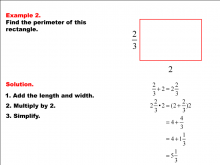
|
Math Example--Area and Perimeter--Rectangle Perimeter with Fractions--Example 2 | Rectangle Perimeter with Fractions--Example 2TopicArea and Perimeter DescriptionThis example illustrates the calculation of a rectangle's perimeter with fractional dimensions. By applying the formula P = 2 ( l + w ), students practice adding fractions, honing skills in both fraction arithmetic and multiplication. This task is critical for understanding how to handle fractions in geometric contexts, thereby enhancing both mathematical and spatial reasoning skills. |
Fractions and Mixed Numbers |
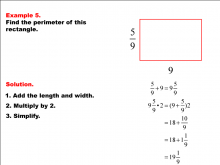
|
Math Example--Area and Perimeter--Rectangle Perimeter with Fractions--Example 5 | Rectangle Perimeter with Fractions--Example 5TopicArea and Perimeter DescriptionThis example illustrates how to compute the perimeter of a rectangle with fractional side lengths using the formula P = 2 ( l + w ). Students engage in adding fractions, enhancing skills in fraction arithmetic and multiplication. This example serves to reinforce understanding of geometric properties and the application of mathematical formulas involving fractions, crucial for solving perimeter-related problems effectively. |
Fractions and Mixed Numbers |

|
Math Example--Area and Perimeter--Rectangle Perimeter with Fractions--Example 1 | Rectangle Perimeter with Fractions--Example 1TopicArea and Perimeter DescriptionThis example demonstrates how to calculate the perimeter of a rectangle when dimensions are given as fractions. Using the formula P = 2 ( l + w ), students practice adding fractional lengths, enhancing skills in fraction addition and multiplication. This exercise is designed to improve understanding of both arithmetic operations with fractions and geometric concepts, making it a comprehensive learning experience. |
Fractions and Mixed Numbers |
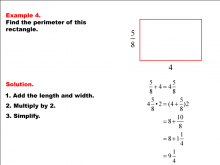
|
Math Example--Area and Perimeter--Rectangle Perimeter with Fractions--Example 4 | Rectangle Perimeter with Fractions--Example 4TopicArea and Perimeter DescriptionThis example demonstrates the process of calculating a rectangle's perimeter with fractional dimensions using the formula P = 2 ( l + w ). Students practice adding fractions, focusing on arithmetic skills and multiplication. This exercise enhances understanding of how fractions are applied in geometric contexts, improving both computational and spatial reasoning skills. |
Fractions and Mixed Numbers |
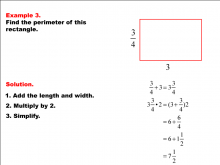
|
Math Example--Area and Perimeter--Rectangle Perimeter with Fractions--Example 3 | Rectangle Perimeter with Fractions--Example 3TopicArea and Perimeter DescriptionThis example focuses on perimeter calculation for rectangles with fractional side lengths. Using the formula P = 2 ( l + w ), students practice adding fractions, reinforcing skills in fraction arithmetic and multiplication. This example is designed to deepen understanding of geometric concepts and the practical application of mathematical formulas involving fractions. |
Fractions and Mixed Numbers |

|
Math Example--Area and Perimeter--Rectangle Perimeter with Fractions--Example 4 | Rectangle Perimeter with Fractions--Example 4TopicArea and Perimeter DescriptionThis example demonstrates the process of calculating a rectangle's perimeter with fractional dimensions using the formula P = 2 ( l + w ). Students practice adding fractions, focusing on arithmetic skills and multiplication. This exercise enhances understanding of how fractions are applied in geometric contexts, improving both computational and spatial reasoning skills. |
Fractions and Mixed Numbers |

|
Math Example--Area and Perimeter--Rectangle Perimeter with Fractions--Example 5 | Rectangle Perimeter with Fractions--Example 5TopicArea and Perimeter DescriptionThis example illustrates how to compute the perimeter of a rectangle with fractional side lengths using the formula P = 2 ( l + w ). Students engage in adding fractions, enhancing skills in fraction arithmetic and multiplication. This example serves to reinforce understanding of geometric properties and the application of mathematical formulas involving fractions, crucial for solving perimeter-related problems effectively. |
Fractions and Mixed Numbers |

|
Math Example--Area and Perimeter--Rectangle Perimeter with Fractions--Example 5 | Rectangle Perimeter with Fractions--Example 5TopicArea and Perimeter DescriptionThis example illustrates how to compute the perimeter of a rectangle with fractional side lengths using the formula P = 2 ( l + w ). Students engage in adding fractions, enhancing skills in fraction arithmetic and multiplication. This example serves to reinforce understanding of geometric properties and the application of mathematical formulas involving fractions, crucial for solving perimeter-related problems effectively. |
Fractions and Mixed Numbers |

|
Math Example--Area and Perimeter--Rectangle Perimeter with Fractions--Example 1 | Rectangle Perimeter with Fractions--Example 1TopicArea and Perimeter DescriptionThis example demonstrates how to calculate the perimeter of a rectangle when dimensions are given as fractions. Using the formula P = 2 ( l + w ), students practice adding fractional lengths, enhancing skills in fraction addition and multiplication. This exercise is designed to improve understanding of both arithmetic operations with fractions and geometric concepts, making it a comprehensive learning experience. |
Fractions and Mixed Numbers |

|
Math Example--Area and Perimeter--Rectangle Perimeter with Fractions--Example 1 | Rectangle Perimeter with Fractions--Example 1TopicArea and Perimeter DescriptionThis example demonstrates how to calculate the perimeter of a rectangle when dimensions are given as fractions. Using the formula P = 2 ( l + w ), students practice adding fractional lengths, enhancing skills in fraction addition and multiplication. This exercise is designed to improve understanding of both arithmetic operations with fractions and geometric concepts, making it a comprehensive learning experience. |
Fractions and Mixed Numbers |

|
Math Example--Area and Perimeter--Rectangle Perimeter with Fractions--Example 3 | Rectangle Perimeter with Fractions--Example 3TopicArea and Perimeter DescriptionThis example focuses on perimeter calculation for rectangles with fractional side lengths. Using the formula P = 2 ( l + w ), students practice adding fractions, reinforcing skills in fraction arithmetic and multiplication. This example is designed to deepen understanding of geometric concepts and the practical application of mathematical formulas involving fractions. |
Fractions and Mixed Numbers |

|
Math Example--Area and Perimeter--Rectangle Perimeter with Fractions--Example 2 | Rectangle Perimeter with Fractions--Example 2TopicArea and Perimeter DescriptionThis example illustrates the calculation of a rectangle's perimeter with fractional dimensions. By applying the formula P = 2 ( l + w ), students practice adding fractions, honing skills in both fraction arithmetic and multiplication. This task is critical for understanding how to handle fractions in geometric contexts, thereby enhancing both mathematical and spatial reasoning skills. |
Fractions and Mixed Numbers |

|
Math Example--Area and Perimeter--Rectangle Perimeter with Fractions--Example 3 | Rectangle Perimeter with Fractions--Example 3TopicArea and Perimeter DescriptionThis example focuses on perimeter calculation for rectangles with fractional side lengths. Using the formula P = 2 ( l + w ), students practice adding fractions, reinforcing skills in fraction arithmetic and multiplication. This example is designed to deepen understanding of geometric concepts and the practical application of mathematical formulas involving fractions. |
Fractions and Mixed Numbers |

|
Math Example--Area and Perimeter--Rectangle Perimeter with Fractions--Example 5 | Rectangle Perimeter with Fractions--Example 5TopicArea and Perimeter DescriptionThis example illustrates how to compute the perimeter of a rectangle with fractional side lengths using the formula P = 2 ( l + w ). Students engage in adding fractions, enhancing skills in fraction arithmetic and multiplication. This example serves to reinforce understanding of geometric properties and the application of mathematical formulas involving fractions, crucial for solving perimeter-related problems effectively. |
Fractions and Mixed Numbers |

|
Math Example--Area and Perimeter--Rectangle Perimeter with Fractions--Example 2 | Rectangle Perimeter with Fractions--Example 2TopicArea and Perimeter DescriptionThis example illustrates the calculation of a rectangle's perimeter with fractional dimensions. By applying the formula P = 2 ( l + w ), students practice adding fractions, honing skills in both fraction arithmetic and multiplication. This task is critical for understanding how to handle fractions in geometric contexts, thereby enhancing both mathematical and spatial reasoning skills. |
Fractions and Mixed Numbers |